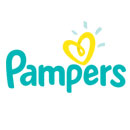
Pampers
Cincinnati, OhioFounding:
Pampers, a brand of baby products primarily known for its diapers, was founded by Procter & Gamble (P&G) in the early 1960s. It was a response to the challenges faced by parents using cloth diapers, offering a disposable alternative that was more convenient and hygienic.Milestones:
1961: Pampers was introduced and became the first disposable diaper to hit the market.
1971: Pampers introduced a new design, leading to better absorption and reduced leakage.
1980s: Pampers added features like elastic leg gathers and tabs for better fit and convenience.
2000s: Introduced "Dry Max" technology for thinner diapers with enhanced absorbency.
Recent years: Continued innovation in materials, designs, and sustainability efforts.
Evolution:
Pampers evolved from basic disposable diapers to incorporating advanced technology for better comfort, absorption, and fit. It adapted to changing consumer needs by focusing on features like dryness, skin-friendliness, and eco-friendliness.Cultural Context:
The rise of Pampers coincided with societal changes, including more women entering the workforce. This led to a higher demand for convenient baby care solutions, contributing to the brand's success.Positioning & Brand Values:
Pampers positioned itself as a brand focused on baby comfort, dryness, and convenience for parents. Its core values revolve around innovation, quality, and a commitment to baby care.Product Design:
Pampers' product design has constantly evolved to incorporate new materials, better absorption, and ergonomic fits to prevent leaks and ensure comfort.Visual Evolution:
The Pampers logo and packaging have undergone several updates over the years, reflecting modernity, simplicity, and a focus on the product's benefits.Successes and Challenges:
Successes include becoming a household name in baby care globally. Challenges involved competition, environmental concerns regarding disposable diapers, and addressing diverse consumer needs.Controversies:
Pampers faced controversies related to chemical sensitivities and alleged allergic reactions in babies, although extensive research and modifications in product formulations were made to address these concerns.Product Range:
Pampers expanded its product range to include various types of diapers (premium, sensitive, overnight) and baby wipes, catering to different preferences and needs of parents and babies.Major consumer markets by geography:
Pampers has a significant global presence, with a strong market in North America, Europe, Asia-Pacific, and emerging markets due to its brand recognition and quality.Competitors in Different Segments:
Competitors include Huggies (Kimberly-Clark), Luvs (P&G), and various local brands globally, competing on factors like price, quality, and innovative features.Revenue Streams & Financials:
Pampers contributes significantly to P&G's revenue. Financially, it's considered a major contributor to the company's overall success and growth.- Other Brands
- Apple
- Microsoft
- Amazon
- Google
- Samsung
- Toyota
- Mercedes-Benz
- Coca-Cola
- Nike
- BMW
- McDonald’s
- Tesla
- Disney
- Louis Vuitton
- Cisco
- Instagram
- Adobe
- IBM
- Oracle
- SAP
- Facebook
- Chanel
- Hermes Paris
- Intel
- YouTube
- JP Morgan
- Honda
- American Express
- Ikea
- Accenture
- Allianz
- Hyundai
- UPS
- Gucci
- Pepsi
- Sony
- Visa
- Salesforce
- Netflix
- PayPal
- Mastercard
- Adidas
- ZARA
- AXA
- Audi
- airbnb
- Porsche
- Starbucks
- GE
- Volkswagen
- Ford
- Nescafe
- Siemens
- Goldman Sachs
- Pampers